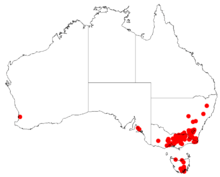Acacia pravissima
Acacia pravissima, commonly known as Ovens wattle, Oven wattle, wedge-leaved wattle and Tumut wattle, is a species of flowering plant in the legume family Fabaceae. It is an evergreen shrub native to Victoria, the South West Slopes and Southern Tablelands of New South Wales, Australia.[1][2]
| Ovens wattle | |
|---|---|
.jpg) | |
| Scientific classification | |
| Kingdom: | Plantae |
| Clade: | Tracheophytes |
| Clade: | Angiosperms |
| Clade: | Eudicots |
| Clade: | Rosids |
| Order: | Fabales |
| Family: | Fabaceae |
| Clade: | Mimosoideae |
| Genus: | Acacia |
| Species: | A. pravissima |
| Binomial name | |
| Acacia pravissima | |
 | |
| Occurrence data from AVH | |
Description
The tree or shrub typically grows to a height of 0.5 to 3 m (1 ft 8 in to 9 ft 10 in) but can grow as tall as 8 m (26 ft) and has slender to spreading branches. The ribbed branchlets can be either glabrous or hairy. Like most species of Acacia it has phyllodes rather than true leaves. The gre-green coloured and crowded, on short stem-projections. The glabrous phyllodes are quite inequilateral with an obdeltate shape with a length of 7 to 16 cm (2.8 to 6.3 in) and a width of 5 to 14 mm (0.20 to 0.55 in).[2] It produces racemes of ball-shaped yellow flowers in winter and spring.[3] The prolific inflorescences have spherical flower-heads with a diamter of 5 to 6 mm (0.20 to 0.24 in) containing 8 to 12 golden coloured flowers. Following flowering firmly chartaceous and glabrous seed pods form that have a narrowly oblong shape with a length of up to 8 cm (3.1 in) and a width of 6 to 9 mm (0.24 to 0.35 in). The dull black seeds inside have an oblong to ovate shape with a length of 3 to 5 mm (0.12 to 0.20 in) and a clavate aril.[2]
Taxonomy
The species was first formally described in 1853 by the botanist Ferdinand von Mueller as a part of the work First general report of the Government Botanist on the vegetation of the colony. Victoria as published in the Votes and Proceedings of the Legislative Assembly of the Victorian Parliament. It was reclassified as Racosperma pravissimum by Leslie Pedley in 2006 then returned to genus Acacia in 2006.[4] The Latin specific epithet pravissima means "very crooked".[5]
Distribution
In is endemic to south-eastern Australia in the more elevated areas of the Great Dividing Range from around Tumut in New South Wales in the north through the Cotter Range and Australian Capital Territory down to around the Strathbogie Range and Macalister River in Victoria. It is often situated damp sheltered sites and along creeks and streams usually as a part of Eucalyptus forest and woodland communities.[2]
Cultivation
In temperate regions it is hardy only in mild or warm coastal climates, but must be given a sheltered spot in full sun with neutral or acid soil. Elsewhere it should be grown under glass. This plant has gained the Royal Horticultural Society's Award of Garden Merit. It has gained the Royal Horticultural Society's Award of Garden Merit.[3][6]
Gallery
See also
References
- "Acacia pravissima F.Muell". National Herbarium of New South Wales. PlantNET. Retrieved 10 April 2010.
- "Acacia pravissima F.Muell". Wattle - Acacias of Australia. Lucid Central. Retrieved 26 July 2020.
- "Acacia pravissima". www.rhs.org. Royal Horticultural Society. Retrieved 27 February 2020.
- "Acacia pravissima F.Muell. ex Benth". Atlas of Living Australia. Global Biodiversity Information Facility. Retrieved 26 July 2020.
- Harrison, Lorraine (2012). RHS Latin for Gardeners. United Kingdom: Mitchell Beazley. ISBN 184533731X.
- "AGM Plants - Ornamental" (PDF). www.rhs.org. Royal Horticultural Society. November 2018. p. 107. Retrieved 27 February 2020.
- R Lancaster, (1998). Plants That Should Be Better Known: Acacia pravissima, Royal Horticultural Society..
External links

